Introduction and Package
Introduction
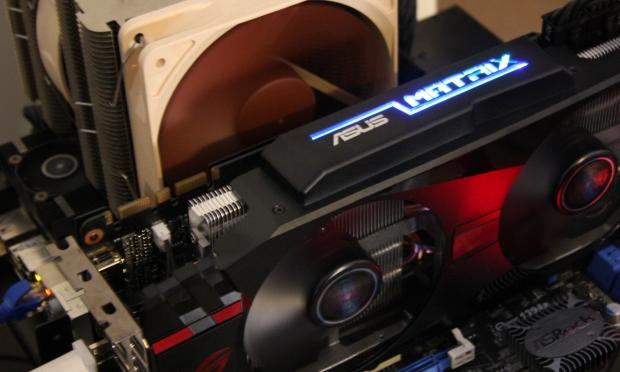
Over the last few months we've seen MSI do some wonderful things to the GTX 580, releasing the model into its Lightning series and then during Computex re-releasing the GTX 580 in 3GB form also under the Lightning series; but in this case it was the Lightning Xtreme Edition. Someone else has done something with the GTX 580, but I can't really remember who; it's probably got something to do with the fact we haven't seen it.
Anyway, the latest company to go all out with the model is ASUS with it getting the ROG MATRIX treatment. Imagine a facial with an electric sander to make everything smooth. It's big, it's fat, it's got lots of extra buttons and it looks powerful. Today we intend to find out if it performs as good as it looks, because oh does it looks good.
We'll start off today by looking at the package ASUS has put together. Once that's done we'll take a close look at the card and see some of the features it offers us when compared to other GTX 580s. We'll then get into the specifications side of things and cover overclocking, as we'll be testing the card overclocked today.
Once we've done all that, we'll take a quick look at our testbed before we then get stuck into the performance side of things to see just what kind of power this GTX 580 is able to offer us. Before we get into the fun stuff, let us first check out this chunky looking package that resembles a ROG motherboard box more than a video card.
Package
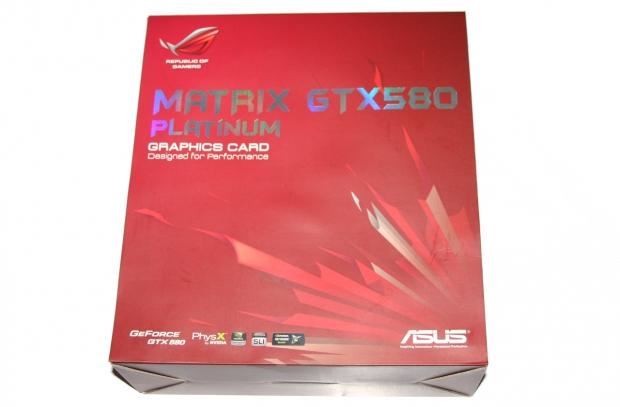
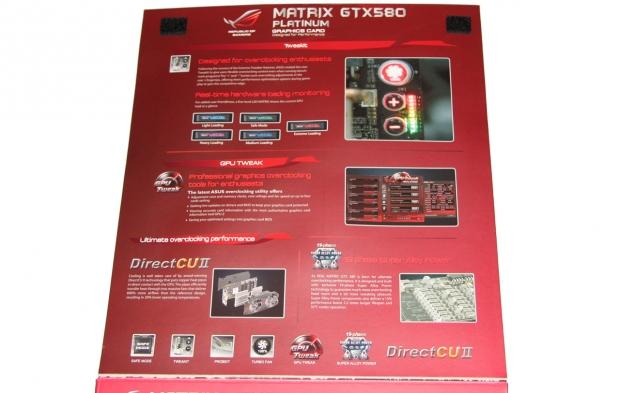
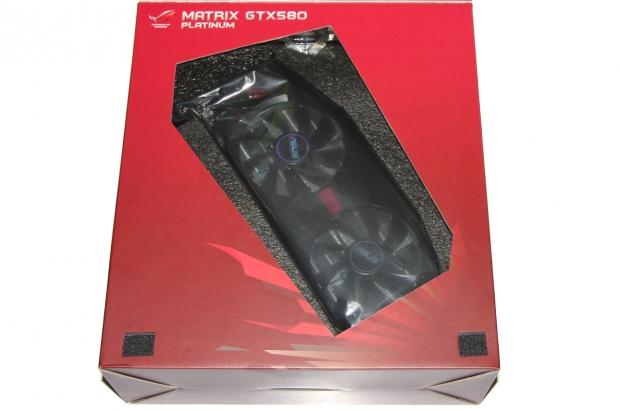
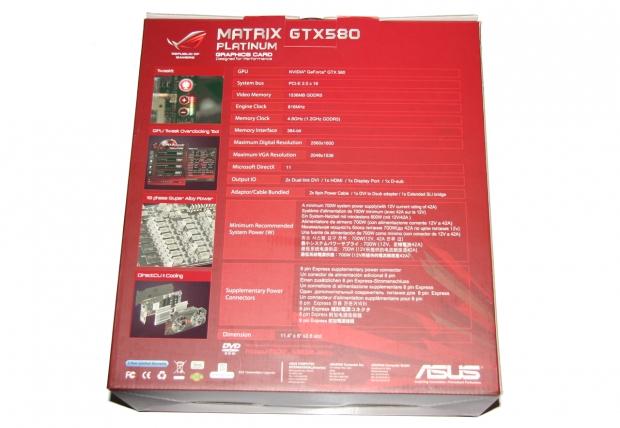
There's an absolute heap of information when it comes to the box due to ASUS choosing to follow that typical ROG setup, which sees the box open up to show us all the little extras that the card offers. We can also see the card, but because of the anti-static bag it's in, you don't get the best look.
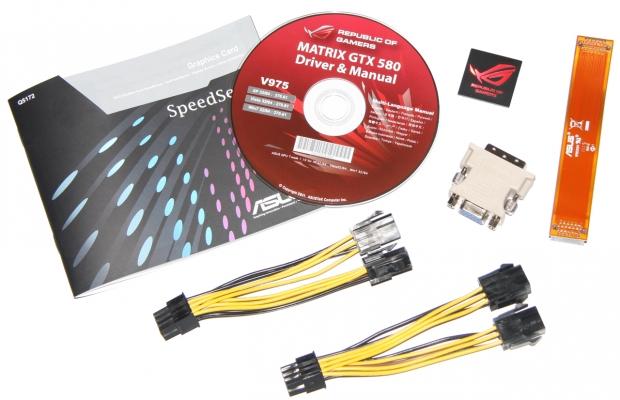
Moving inside the package isn't as big as I thought it probably would be. With the box being so big, I probably expected to see a bit more inside. With that said, though, and everything pulled out, I'm not really sure what more we could get from them. Apart from some games we probably don't want or a huge sticker, we've really got everything we need to get up and running. This includes SpeedSetup Guide, Driver CD, two Dual-6-Pin to 8-Pin PCI-E connectors, DVI to VGA, large SLI bridge and a nice little ROG case badge.
The Card
Pulling the card out of the box and looking at it head on doesn't really give us the best idea of just how big the card is. It's big, though, taking up three slots and carrying with it two extra-large 100mm fans.
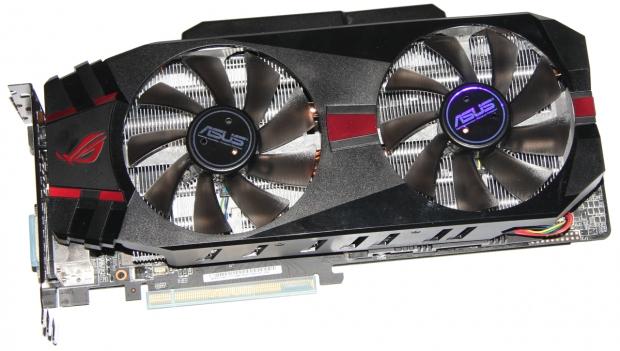
As we move around the card, we've got some familiar sights. Up the back we've got two power connectors. In this case, though, they're in the form of two 8-Pin which is something we're seeing with these more modified GTX 580s. Closer to the front we've also got two SLI connectors which means we could have up to four cards running. Because of the triple slot design, though, we don't like your chances of making use of that many.
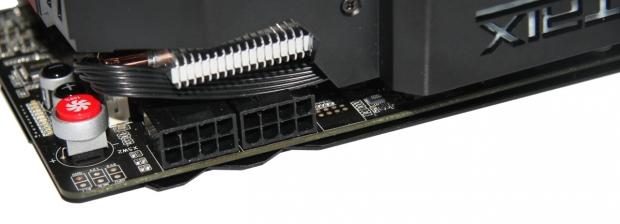
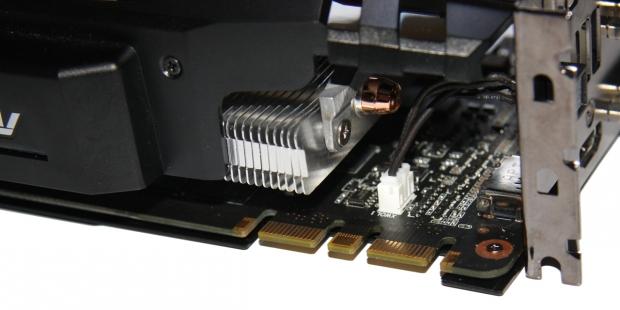
If we turn the card over, we've got a massive back plate that covers the entire card. Towards the middle, though, you can see a little chip visible. This NEC chip provides power to the GPU and what ASUS has done is place it directly behind the GPU. What this means is that the amount of distance that the power has to travel is so minimal that it means less power loss is seen and will overall make for a more stable card at higher clock speeds.
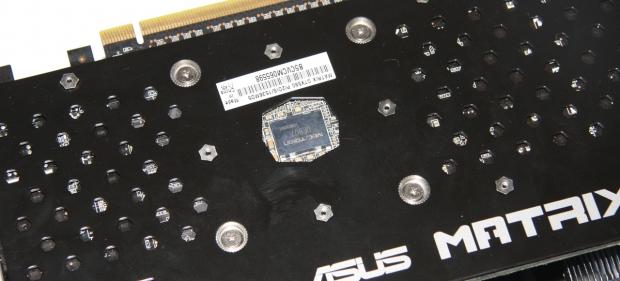
Around the back if we look at the top right corner you will see eight little dots. If you're a power user who's looking at going down the LN2 path to break some records, with soldering equipment you're able to solder these points together to unlock even more overclocking features. This is something for the most hardcore of overclockers, though, and while you're able to do this kind of stuff on other GTX 580s, the way ASUS has done it by making it extremely easy to access, it can be done a lot easier.
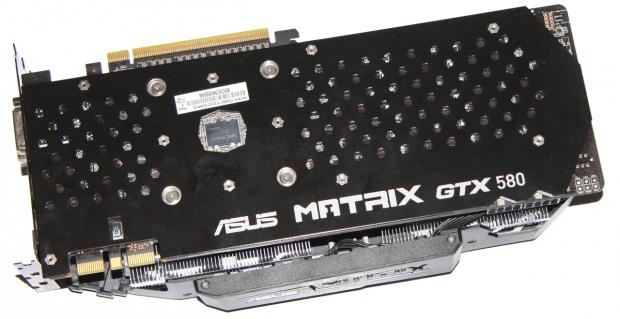
If we move around the card a bit more, we can start to see some of the other features that are available on the card. Moving back around to where the power connectors are, you can see we've got three buttons here.
The plus and minus button relates to voltage adjustment. While in the ASUS overclocking software we're able to adjust the voltage to 1.150v, using the buttons we're able to push voltage above 1.25v. If you're going to go that high, though, we wouldn't recommend doing so without hitting the red button which will instantly push your fan speed to 100% and remove the need to do it via software.
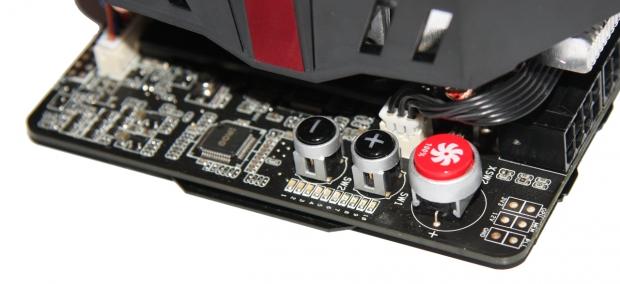
Originally I found myself thinking that this was a bit pointless, but having played around with the card a bit now, it's actually quite handy. If you want to do some higher voltage overclocking so you can play around with 3DMark 11 benching or something like that, you can get your fan up to 100% at a touch of a button instead of having to mess around with fan profiles. You can leave it at 100% after your benchmark has ran so the core temp drops back down and then with a touch of a button it's back in AUTO mode.
Just above the 100% Fan button we've got six little voltage points. This is for the Probelt feature that we've seen from ASUS before. We're able to grab the actual voltage that's running on the GPU, Memory and PLL which is what we see on the MSI Lightning cards. ASUS also give us the ability to grab the PCI-E voltage as well. Like the ROG motherboards, this isn't a feature a lot of people use, but for the hardcore overclocker it's something that's appreciated.

Across the top of the card like you saw in our intro picture and again above, the MATRIX logo lights up. There isn't just one color for this; instead there are five and all colors represent a different state of load.
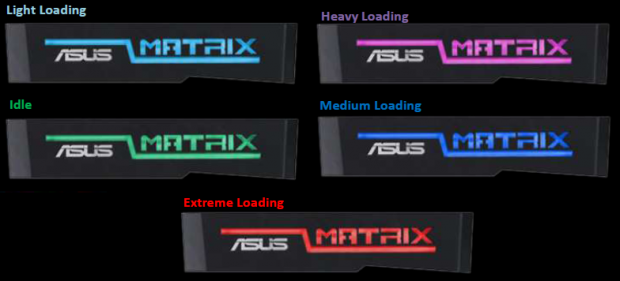
You can see in the above image the five different colors and the amount of load they represent. It looks pretty funky and as you make the card work harder, you can see it via the change of colors on the MATRIX logo.
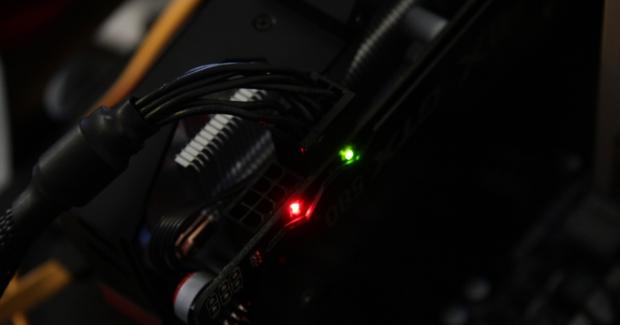
Before we move onto the connection side of things, something else present on the card is a couple of LEDs around the power connectors. This just lets you know if your power connectors are in properly or at all. As you can see above, we've got a red LED for the closest connector to us which doesn't have anything in it and a green LED for the other plug letting us know we're all hooked up perfectly.
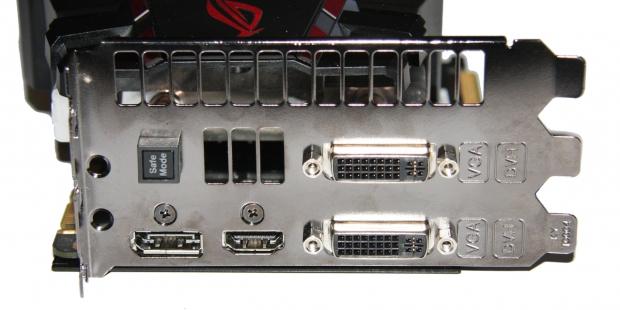
Finally, we move to the I/O side of things. Here we've got two Dual-Link DVI connectors, a full size DisplayPort and a HDMI port. Also present is a little Safe Mode button. In the event you go a bit crazy with the card and you need everything reset to default, you can use this button and all should be right again.
Specifications and Overclocking
Out of the box the GTX 580 MATRIX from ASUS doesn't carry with it anything all that special when it comes to the clocks. We see the core come in at 816MHz, the Shader at 1632MHz and the 1536MB of GDDR5 come in at 4008MHz QDR. For this reason we have chosen to overclock the card and bench it at the overclocked speed we're able to achieve.
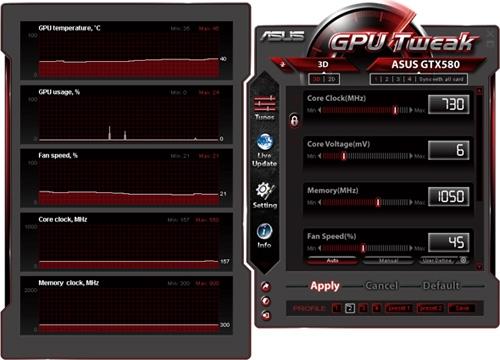
Today, though, we won't be using MSI Afterburner and will instead be using the new GPU Tweak It utility from ASUS. They've finally decided to ditch DumbDoctor; sorry SmartDoctor, and make an overclocking program that looks a whole lot better and offers a load more function.
Like the Lightning cards and Afterburner, the ROG MATRIX card and GPU Tweak It unlocks the ability to do more. Apart from just adjust the core like we're able to do on a lot of other cards, we're able to also adjust the PLL and Memory voltage to help us achieve higher overclocks overall.
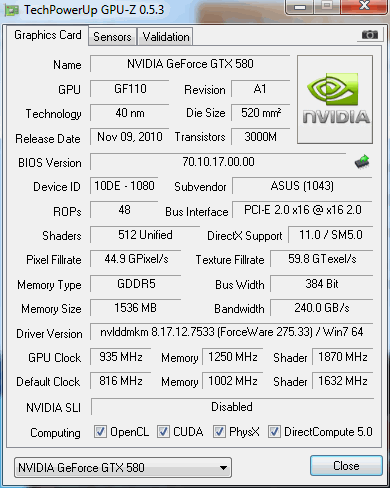
With all this in mind, we ended up with a core clock of 925MHz, Shader clock of 1870MHz and memory clock of 5GHz QDR even. This isn't the highest overclock we've achieved with a GTX 580, but using the default air cooler, ASUS have clearly opted for a path that consists of the card running quieter instead of running louder.
This is great, but without manually adjusting the fan, as we get the voltage up which in turn helps us get the clock speeds up, the card can run quite warm because the fan continues to spin with low noise being in mind. We won't get into specifics yet and instead will wait till we cover the fan noise and card temperature later.
What we can say, though, was hitting the 100% fan speed and cranking the voltages up, we ended up at 970MHz on the core and 5100MHz QDR on the memory. This is a nice overclock, but since it wasn't a huge amount faster than when the fan was on auto, we opted to go for the slightly lower clocks with fan on auto instead of the higher clocks and the fan on 100%. Of course, if you want to do some specific benchmarking, you know the option to go to 100% is there and you're able to net yourself some extra MHz thanks to being able to run extra voltage safely through the card.
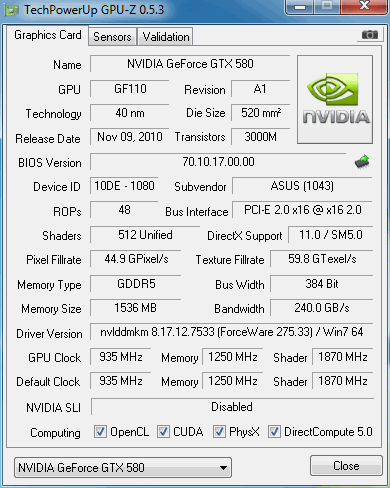
Quickly before we move onto testing, though, the "Burn" feature in GPU Tweak It was something I wanted to quickly cover. I love this little feature; with our core set to 935MHz and our memory at 5000MHz QDR we're able to save the profile like we normally would with MSI Afterburner. That way, when we fire up Windows we can just hit Profile 1 and everything is at what we want. If we hit the Burn button, though, we're able to update the BIOS on the card with our own clocks. As you can see in the above GPU-Z screen, no longer is the default setup on the card 816 / 1002 (4008 QDR) / 1632, it's now at 932 / 1250 (5000 QDR) / 1870.
This means if I uninstalled the overclocking software or took the card to another computer, the card would be running at my safe overclocked settings straight away without doing anything. Of course, if something goes wrong, we've got the Safe Mode button on the back which resets our BIOS, but the ability to easily burn a profile to the BIOS is really cool.
GPU Tweak It is really powerful software and while there are a few things I would change about it, ASUS have done a good job of expanding on features that MSI Afterburner offer us. Hopefully I'll get the chance to do a separate article covering the software top to bottom and see what features are lost when we throw another branded card into it. One of the best features to MSI Afterburner is that we can throw any brand card in it and we are still able to make use of features like core voltage adjustment.
Test System Setup and 3DMark 11
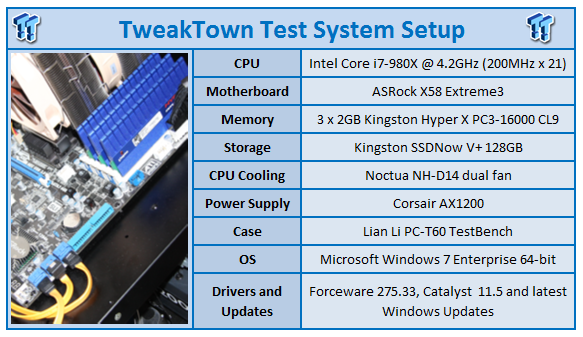
We would like to thank the following companies for supplying and supporting us with our test system hardware and equipment: Intel, ASRock, Kingston, Mittoni, Noctua and Corsair.
Looking at our testbed, there's no surprises. As for the cards we're comparing against, we've got a bunch here. Of course, one of the main things we'll be looking at is how our overclocked ASUS GTX 580 goes against the reference model, but we've also got a number of other setups including GTX 560 in SLI, GTX 590, HD 6970, HD 6970 Lightning overclocked, HD 6950 in CF and HD 6990.
We've got a strong lineup of cards, but as we just mentioned, the main thing we'll be looking at today is the kind of performance we're able to get against that reference clocked model.
Let's get started!
3DMark 11
Version and / or Patch Used: 1.0
Developer Homepage: http://www.futuremark.com
Product Homepage: http://www.3dmark.com/3dmark11/
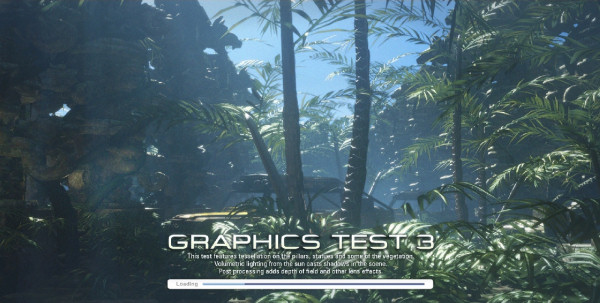
3DMark 11 is the latest version of the world's most popular benchmark. Designed to measure your PC's gaming performance 3DMark 11 makes extensive use of all the new features in DirectX 11 including tessellation, compute shaders and multi-threading. Trusted by gamers worldwide to give accurate and unbiased results, 3DMark 11 is the best way to consistently and reliably test DirectX 11 under game-like loads.
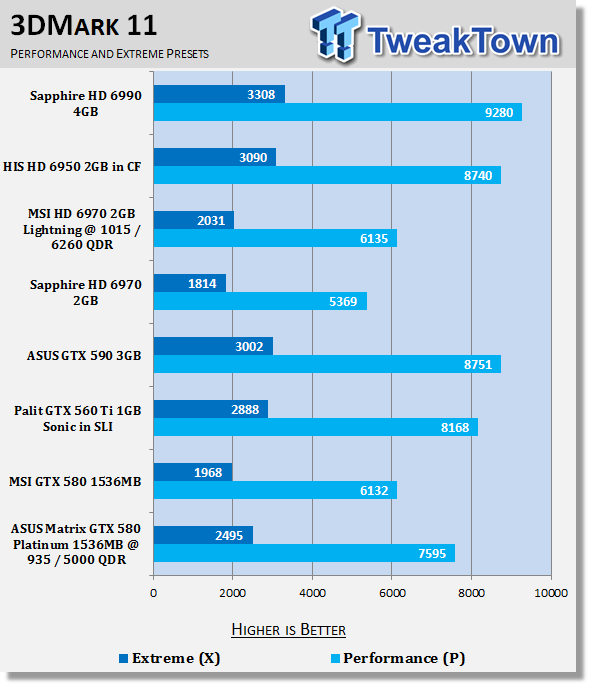
You can see straight away the massive performance increase we're able to get with this overclock on hand. You can see we're not all that far away from the SLI GTX 560 setup. Compared to the AMD options, you can see nothing is really able to compete with it until a second GPU is thrown into the mix.
3DMark Vantage
Version and / or Patch Used: 1.0.1
Developer Homepage: http://www.futuremark.com
Product Homepage: http://www.futuremark.com/products/3dmarkvantage/
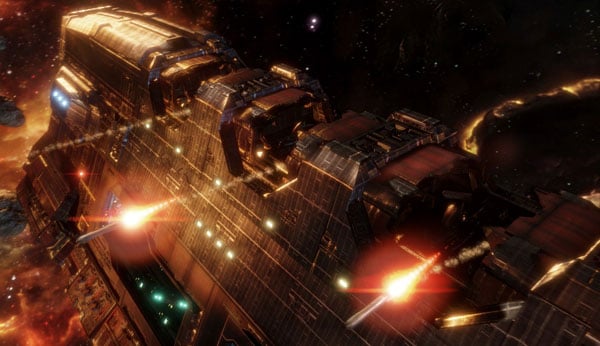
3DMark Vantage is the new industry standard PC gaming performance benchmark from Futuremark, newly designed for Windows Vista and DirectX10. It includes two new graphics tests, two new CPU tests, several new feature tests, and support for the latest hardware.
3DMark Vantage is based on a completely new rendering engine, developed specifically to take full advantage of DirectX10, the new graphics API from Microsoft.
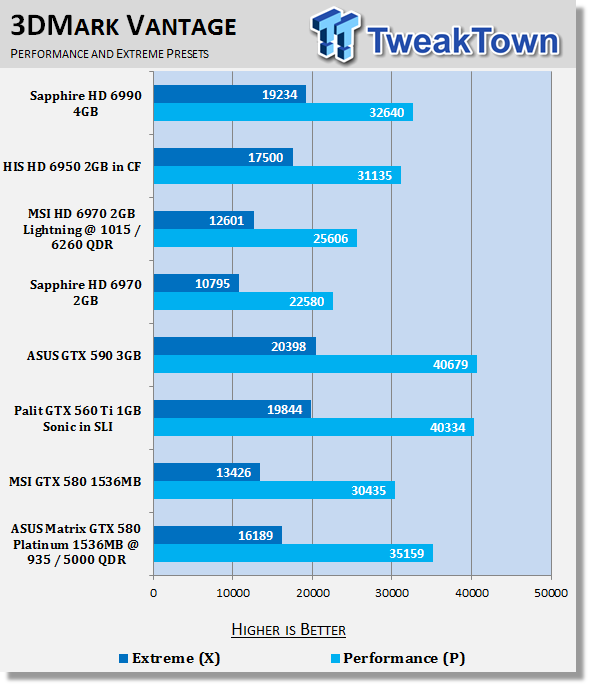
No surprise that under Vantage we see NVIDIA come out well ahead compared to the AMD counterparts, but compared to the reference clocked card you can again see that very strong performance.
Unigine Heaven Benchmark
Version and / or Patch Used: 2
Developer Homepage: http://www.unigine.com
Product Homepage: http://unigine.com/press-releases/091022-heaven_benchmark//
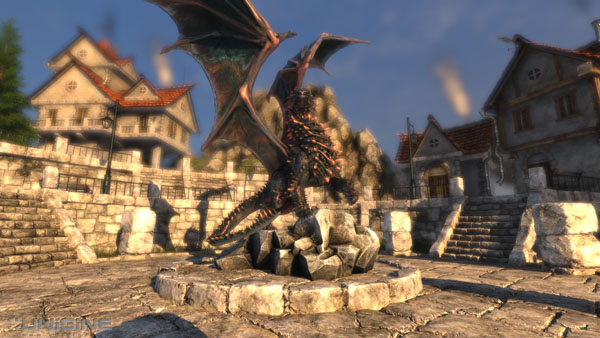
New benchmark grants the power to unleash the DirectX 11 potential in the gift wrapping of impressively towering graphics capabilities. It reveals the enchanting magic of floating islands with a tiny village hidden in the cloudy skies. With the interactive mode emerging experience of exploring the intricate world is ensured within reach. Through its advanced renderer, Unigine is one of the first to set precedence in showcasing the art assets with tessellation, bringing compelling visual finesse, utilizing the technology to the full extend and exhibiting the possibilities of enriching 3D gaming.
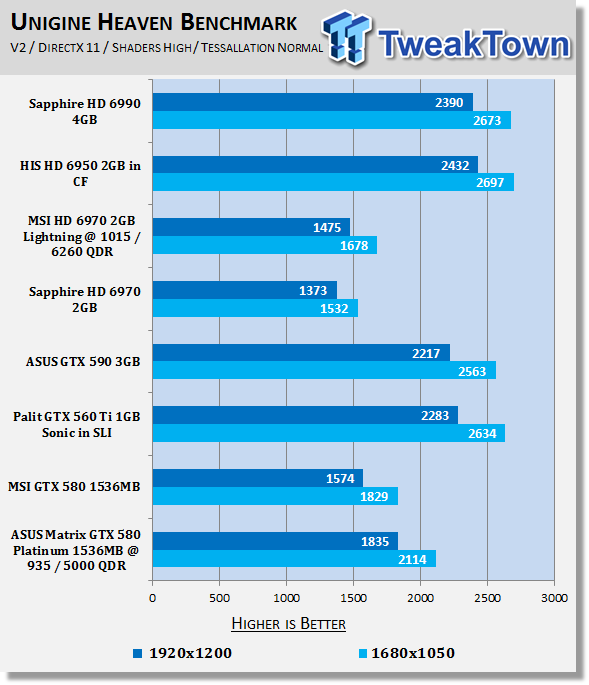
Getting into something a bit more intensive like Unigine Heaven, we can continue to see that very strong performance from the MATRIX. You can see compared to the reference clocked card the MATRIX performs a little better at 1920 x 1200 when compared to the reference card at 1680 x 1050.
Benchmarks - Resident Evil 5
Resident Evil 5
Version and / or Patch Used: Demo Benchmark
Developer Homepage: www.residentevil.com/
Product Homepage: http://www.residentevil.com/

Resident Evil 5 is a survival horror video game developed and published by Capcom. The game is the seventh installment in the Resident Evil survival horror series, and was released on September 18. Resident Evil 5 revolves around Chris Redfield and Sheva Alomar as they investigate a terrorist threat in Kijuju, a fictional town in Africa.
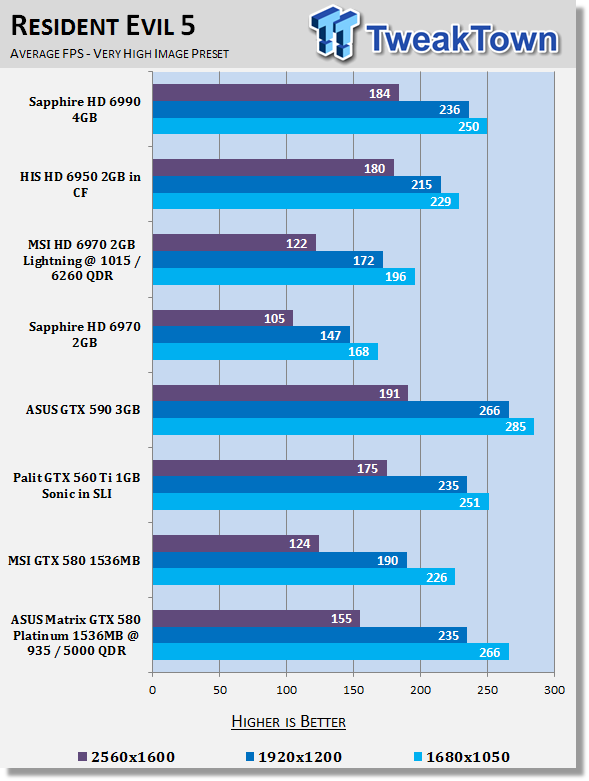
Getting into some RE5, we can see some very strong performance and at 1920 x 1200 and below you can see the GTX 580 MATRIX at these speeds is able to outperform even the GTX 560 SLI setup.
Benchmarks - Tom Clancy's H.A.W.X. 2
Tom Clancy's H.A.W.X.2
Version and / or Patch Used: Benchmark Demo
Timedemo or Level Used: Built-in Test
Developer Homepage: http://www.ubi.com/UK/default.aspx
Product Homepage: http://www.hawxgame.com/

Tom Clancy's H.A.W.X. 2 is an arcade-style flight action game developed by Ubisoft Romania and published by Ubisoft. The game is the sequel to Tom Clancy's H.A.W.X., released in 2009.
The game begins with Colonel David Crenshaw participating in a routine patrol mission in the Middle East. After halting an insurgent attack, a volley of missiles is fired at the Air Force base that Crenshaw was stationed at, with one of the missiles disabling Crenshaw's aircraft, resulting Crenshaw being in enemy captivity. A joint strike force composed of the U.S. Navy, U.S. Air Force, and a Ghost Recon squad executes an operation to rescue Crenshaw. In Scotland, Royal Navy Pilot Colin Munro encounters an unidentified passenger aircraft that explodes from an on-board bomb when undergoing training exercise. In Russia, an air force squadron led by Colonel Denisov and Captain Dmitri Sokov engages separatist aircraft but is ordered to retreat from the region after numerous Russian military installations have been attacked.
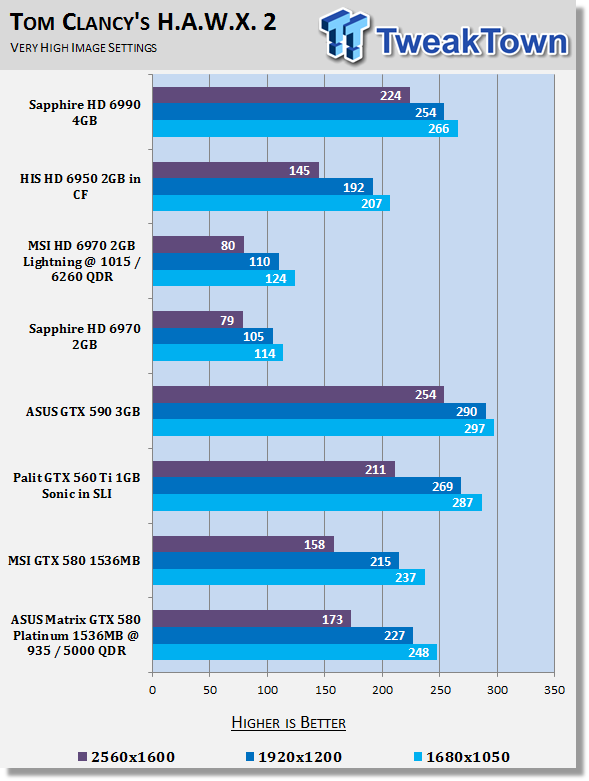
H.A.W.X. 2 starts off a little slow and we don't see much of a performance increase. As we move up in resolution, though, we see the gap become larger and larger as the MATRIX is able to separate itself from the reference clocked card.
Benchmarks - Mafia II
Mafia II
Version and / or Patch Used: Latest Steam Update
Timedemo or Level Used: Built in Benchmark
Developer Homepage: http://www.2kczech.com/
Product Homepage: http://www.mafia2game.com/
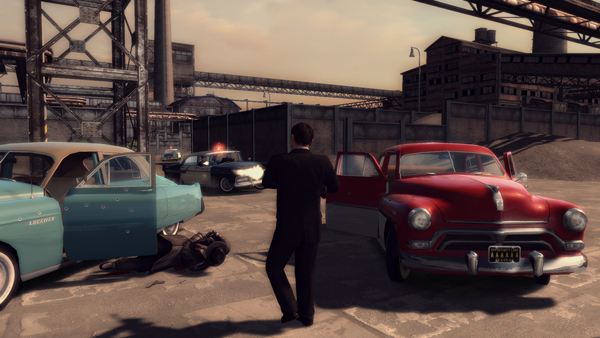
Mafia II is a third-person action-adventure video game, the sequel to Mafia: The City of Lost Heaven. It is developed by 2K Czech, previously known as Illusion Softworks, and is published by 2K Games. The game is set from 1943 to 1951 in Empire Bay (the name is a reference to New York's state nickname "The Empire State"), a fictional city based on San Francisco and New York City, with influences from Chicago and Detroit. The game features a completely open-ended game map of 10 square miles. No restrictions are included from the start of the game. There are around 50 vehicles in the game, as well as licensed music from the era.
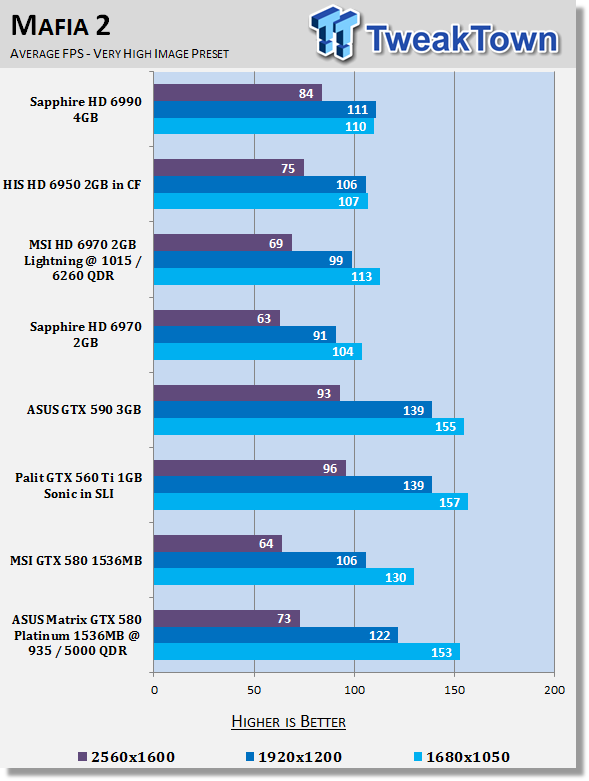
While at the lower resolution we've got no problems getting the FPS we need to play Mafia II, you can see at the highest resolution the reference clocked card is able to only just sneak across that 60 FPS average we aim for. On the other hand, the MATRIX which we've overclocked to over 900MHz on the core sees a strong performance boost that puts it in the 70 FPS realm.
Benchmarks - Lost Planet 2
Lost Planet 2
Version and / or Patch Used: Benchmark Demo
Timedemo or Level Used: Built in Benchmark - Test A Scene 1
Developer Homepage: http://www.capcom.com/
Product Homepage: http://www.lostplanet2game.com/

Lost Planet 2 is a third-person shooter video game developed and published by Capcom. The game is the sequel to Lost Planet: Extreme Condition which is also made by Capcom, taking place ten years after the events of the first game, on the same fictional planet. The story takes place back on E.D.N. III 10 years after the events of the first game. The snow has melted to reveal jungles and more tropical areas that have taken the place of more frozen regions. The plot begins with Mercenaries fighting against Jungle Pirates. After destroying a mine, the Mercenaries continue on to evacuate the area, in which a Category-G Akrid appears and attacks them. After being rescued, they find out their evacuation point (Where the Category-G appeared) was a set-up and no pick up team awaited them. The last words imply possible DLC additions to the game, "There's nothing to be gained by wiping out snow pirates... unless you had some kind of grudge."
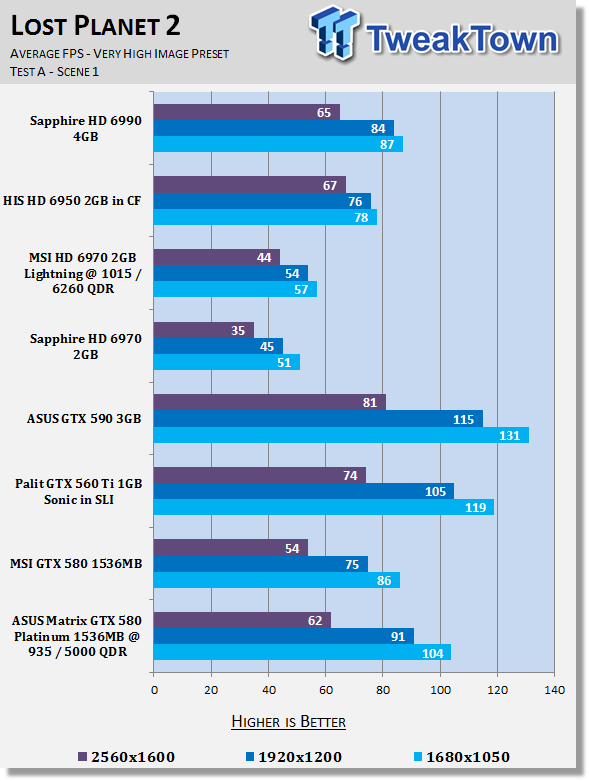
We've got a similar thing happening to Mafia II here, but more extreme. Again you can see we've got playable numbers at 1920 x 1200 and below, but at the highest resolution the reference card isn't able to break that 60 FPS mark we aim for. Overclocked, though, our MATRIX has no problems dealing with it and you can see we're able to score a nice average of 62 FPS.
Benchmarks - Aliens vs. Predator
Aliens vs. Predator
Version and / or Patch Used: Standalone Benchmark
Timedemo or Level Used: Built in Benchmark
Developer Homepage: http://www.rebellion.co.uk/
Product Homepage: http://www.sega.com/games/aliens-vs-predator/

Aliens vs. Predator is a science fiction first-person shooter video game, developed by Rebellion Developments, the team behind the 1999 original PC game, and published by Sega for Microsoft Windows, the PlayStation 3 and the Xbox 360. The game is based on the Alien vs. Predator franchise, a combination of the characters and creatures of the Alien franchise and the Predator franchise. There are three campaigns in the game, one for each race/faction (the Predators, the Aliens and the Colonial Marines), that, while separate in terms of individual plot and gameplay, form one overarching storyline.
Following the storyline of the campaign modes comes the multiplayer aspect of the game. In this Multiplayer section of the game, players face off in various different gametypes in various different ways.
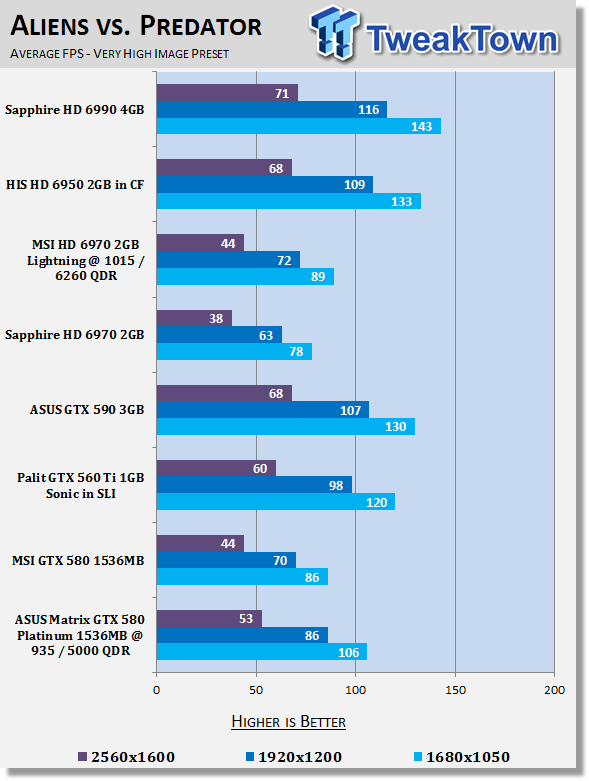
While we continue to see a strong performance increase from the MATRIX when overclocked, in this instance we're just a little too far from our 60 FPS average we want on the reference card. The MATRIX does a good job of closing the gap, but we can't quite hit 60 FPS at the highest resolution.
Benchmarks - Street Fighter IV
Street Fighter IV
Version and / or Patch Used: Standalone Benchmark
Timedemo or Level Used: Built in Benchmark
Developer Homepage: http://www.capcom.com/
Product Homepage: http://www.streetfighter.com/

While Street Fighter IV features models and backgrounds rendered in 3D, the gameplay remains on a traditional 2D plane, with the camera having freedom to move in 3D at certain times during fights, for dramatic effect. Producer Yoshinori Ono has stated that he wanted to keep the game closer to Street Fighter II. A new system called "Focus Attacks" ("Saving Attack" for the Japanese version) has been introduced, as well as Ultra moves. The traditional six-button control scheme returns, with new features and special moves integrated into the input system, mixing classic gameplay with additional innovations.
All the characters and environments in Street Fighter IV are rendered as 3D models with polygons, similar to the Street Fighter EX sub-series Capcom produced with Arika. However, there are a couple of key differences. Art director and character designer Daigo Ikeno, who previously worked on Street Fighter III 3rd Strike, opted for non-photorealistic rendering to give them a hand-drawn look, with visual effects accented in calligraphic strokes, ink smudges and ink sprays during the fights.
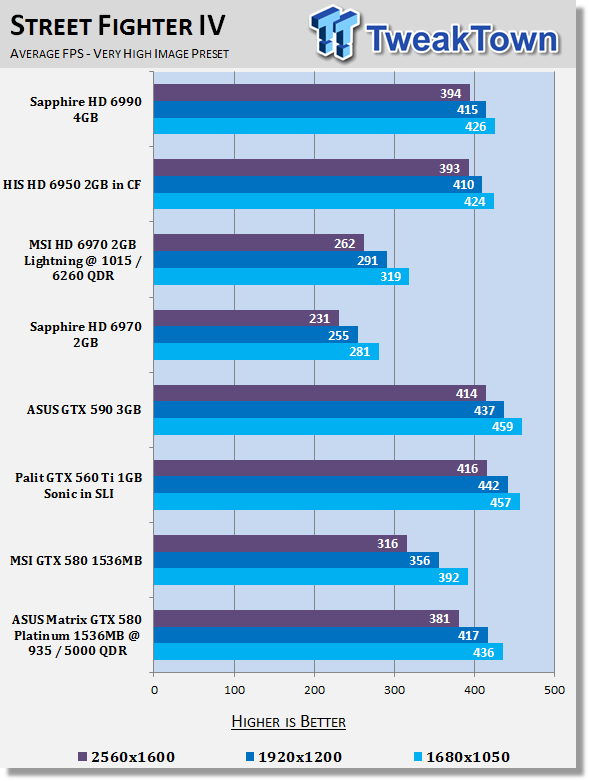
Under SF IV you can see the strong performance gains we get over the reference card at the highest resolution. Sure, it's not needed, but it gives us a good idea on the extra power that's on offer here.
Benchmarks - Far Cry 2
Far Cry 2
Version and / or Patch Used: 1.01
Timedemo or Level Used: Ranch Long
Developer Homepage: http://www.ubi.com/
Product Homepage: http://www.farcry2.com/

The Dunia Engine was built specifically for Far Cry 2 by the award-winning Ubisoft Montreal development team. It delivers the most realistic destructible environments, amazing special effects such as dynamic fire propagation and storm effects, real-time night-and-day cycle, dynamic music system, non-scripted enemy A.I. and so much more.
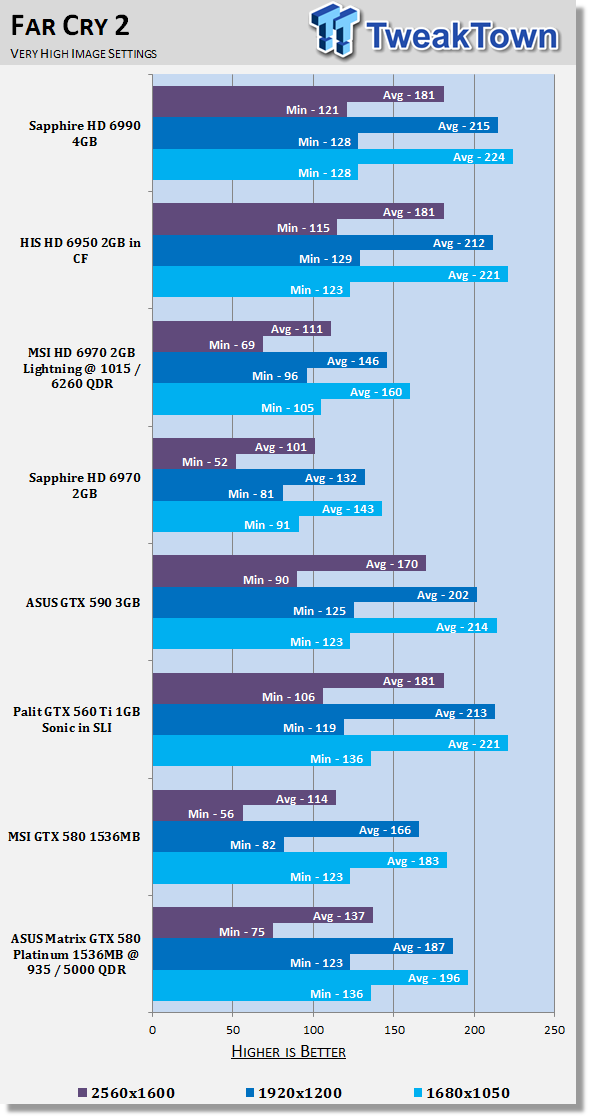
We do see some very strong FPS across the board and you can see overclocked we've just got some massive numbers. You're not going to have any problem playing Far Cry 2 on a card like this, but we get an excellent idea of the kind of performance that's on offer.
Benchmarks - Batman Arkham Asylum
Batman Arkham Asylum
Version and / or Patch Used: 1.1
Timedemo or Level Used: Built-in Test
Developer Homepage: http://www.batmanarkhamasylum.com/
Product Homepage: http://www.batmanarkhamasylum.com/
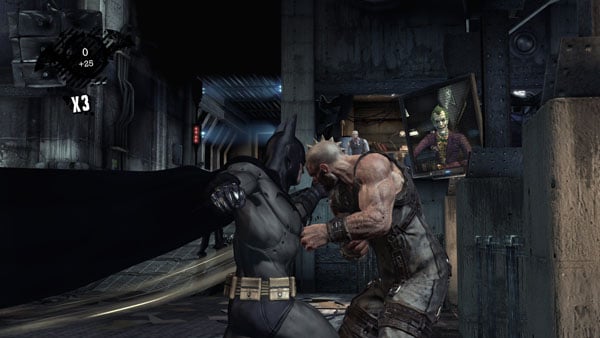
Batman: Arkham Asylum exposes players to a unique, dark and atmospheric adventure that takes them to the depths of Arkham Asylum - Gotham's psychiatric hospital for the criminally insane. Gamers will move in the shadows, instigate fear amongst their enemies and confront The Joker and Gotham City's most notorious villains who have taken over the asylum.
Using a wide range of Batman's gadgets and abilities, players will become the invisible predator and attempt to foil The Joker's demented scheme.
Batman: Arkham Asylum features an original story penned exclusively for the game by famous Batman author and five-time Emmy award winner Paul Dini, whose credits include Lost season one and Batman: The Animated Series.
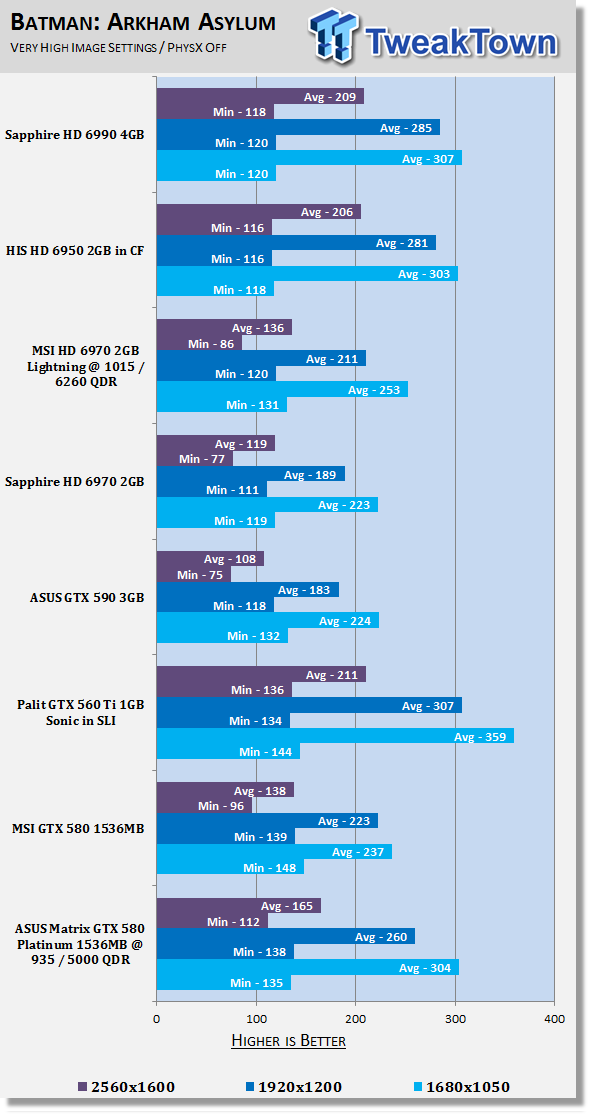
With Far Cry 2 offering such big FPS, it comes as no surprise that Batman AA offers us even larger ones. You can see we've got a bit of a gain over the reference card, but we're already dealing with such large FPS and seem to hit a bit of a wall when it comes to our minimum.
Benchmarks - High Quality AA and AF
High Quality AA and AF
Our high quality tests let us separate the men from the boys and the ladies from the girls. If the cards weren't struggling before they will start to now.
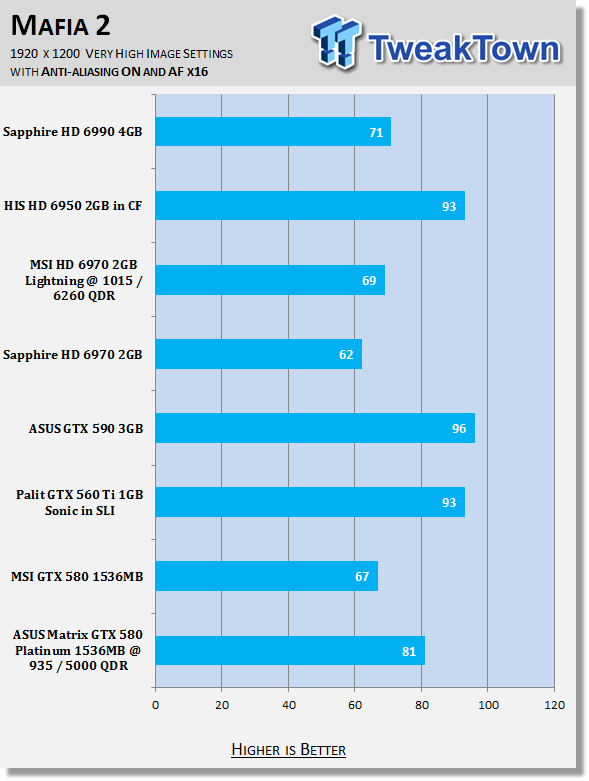
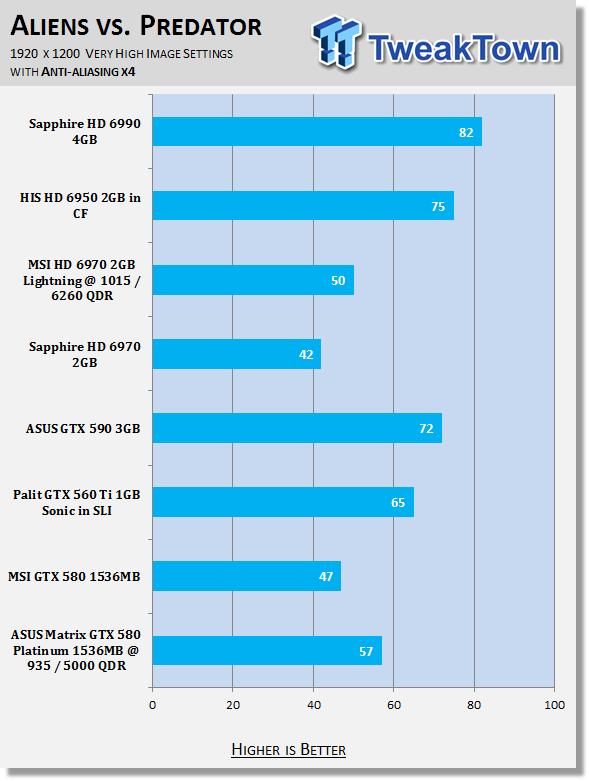
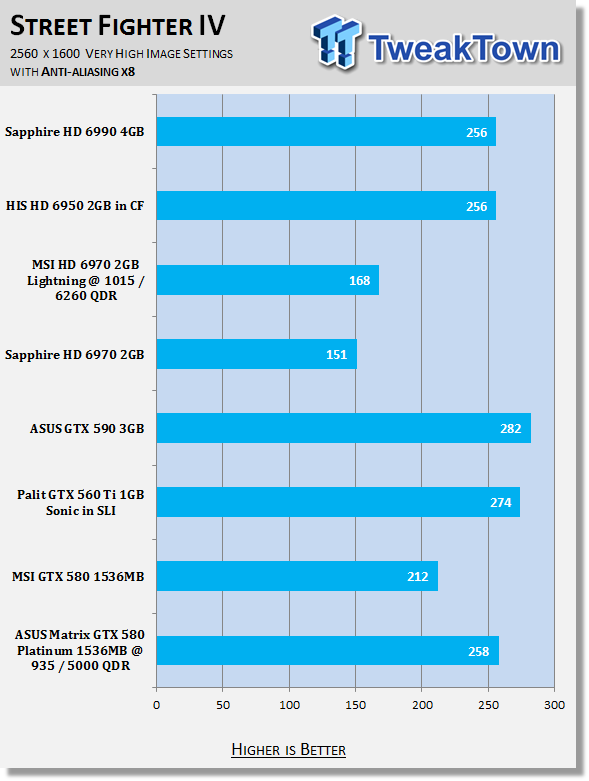
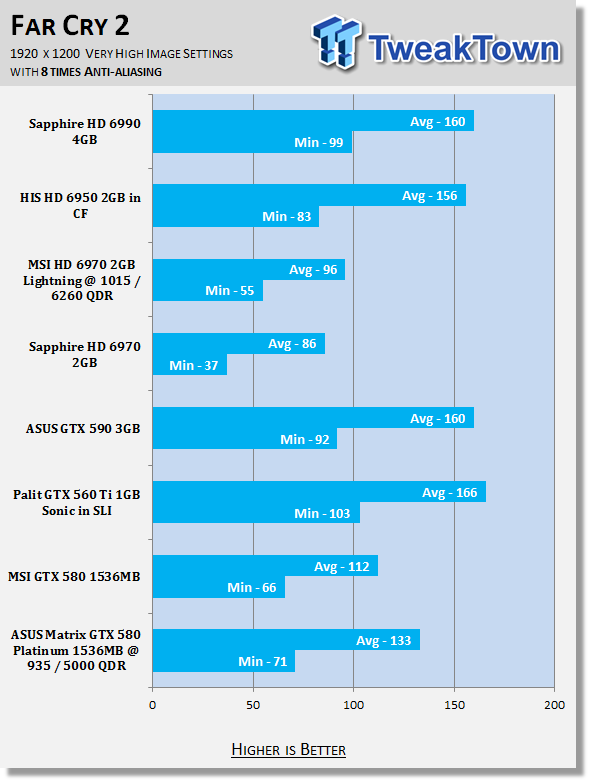
Cranking up the detail and turning on AA and AF, we can see some great performance from the card. We've got playable numbers in everything except Aliens vs. Predator which sees a very strong increase over the reference card, but the MATRIX still falls shy of that 60 FPS average we want. Still, we're right on the edge and moving to something like 2x AA instead of 4x AA should bring the numbers up to the level we want.
Benchmarks - PhysX Tests
PhysX Tests
Here we're able to find out when PhysX is turned on in games that support it what kind of frame rates we're able to get. We always set PhysX to the highest possible in game settings while also keeping detail at its highest.
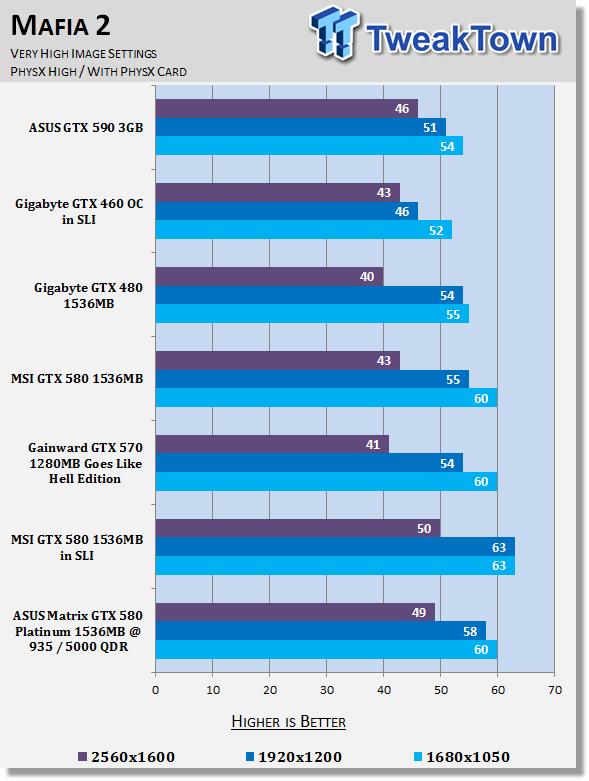
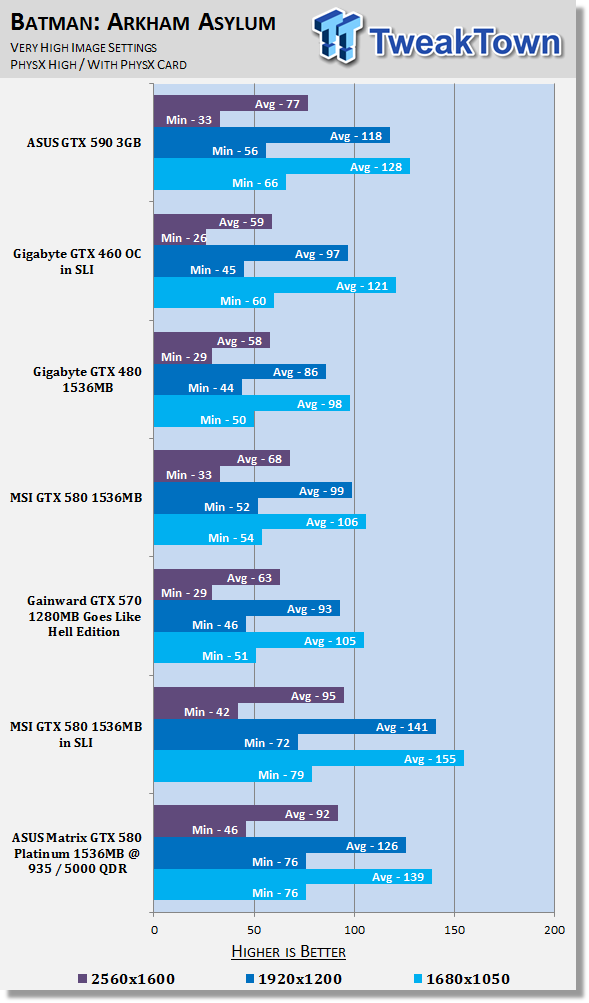
While Batman AA has no problems with PhysX on, you can see under Mafia II we're just scraping in the 60 FPS mark we want at the lowest resolution and we're just shy of it at 1920 x 1200. There clearly seems to be a bit of a wall in Mafia II when PhysX is turned on, but for the most part if it's a technology you want to make use of, you'd probably be better off with a cheaper dedicated card for PhysX and just leave the GTX 580 to do all the other hard work.
Temperature Test
Temperature Tests

The temperature of the core is pulled from MSI Afterburner with the max reading used after a completed run off 3DMark Vantage and the Performance preset.

Looking at the temperature of the card, it's pretty good coming in at 76c. It falls lower than the GTX 580 Lightning and the reference card at reference clocks which comes in at over 80c.
Sound Test
Sound Tests

Pulling out the TES 1350A Sound Level Meter we find ourselves quickly yelling into the top of it to see how loud we can be.
After five minutes of that we get a bit more serious and place the device two CM away from the fan on the card to find the maximum noise level of the card when idle (2D mode) and in load (3D mode).

Being such a large cooler, I probably expected the card to be running a bit cooler. Instead, though, ASUS have opted for noise and you can see this is an extremely quiet GTX 580. Hell, it's an extremely quiet card period coming in at just over 57dB.
When you consider the amount of performance that we're getting from the card, this is an unreal noise level. The fact that it's so quiet is the main reason that when on Auto, we couldn't overclock as high as some of our other GTX 580s we've looked at.
Something worth noting here is that when on 100% fan speed, we measured noise levels of around the 75dB to 76dB mark. Sure, that's loud, but considering the Lightning Xtreme does 72.8dB on Auto, it makes a difference when it comes to finding the maximum overclock.
If we take our MATRIX to similar noise levels, we were able to get the core up higher to 970MHz and the memory to 5100MHz QDR. If you're happy to have the noise, the option is there to crank the fan speed up and get more MHz.
Power Consumption Tests

Using our new PROVA Power Analyzer WM-01 or "Power Thingy" as it has become quickly known as to our readers, we are now able to find out what kind of power is being used by our test system and the associated graphics cards installed. Keep in mind; it tests the complete system (minus LCD monitor, which is plugged directly into AC wall socket).
There are a few important notes to remember though; while our maximum power is taken in 3DMark06 at the same exact point, we have seen in particular tests the power being drawn as much as 10% more. We test at the exact same stage every time; therefore tests should be very consistent and accurate.
The other thing to remember is that our test system is bare minimum - only a SSD hard drive is used with a single CD ROM and minimal cooling fans.
So while the system might draw 400 watts in our test system, placing it into your own PC with a number of other items, the draw is going to be higher.

Power draw is quite high as you'd expect, but it's surprising to see that it manages to come in lower than the reference card and the other GTX 580s we've looked at overclocked.
Total Performance Rating (TPR)
Total Performance Rating
The TPR graph is a combination of all our benchmarks in which NVIDIA and AMD are on an even playing field.
The TPR number is a combination of:
3DMark 11, Heaven Benchmark V2, Resident Evil 5, Tom Clancy's H.A.W.X.2, Mafia 2 (PhysX Off), Lost Planet 2, Aliens vs. Predator, Street Fighter IV, Far Cry 2, Batman: Arkham Asylum (PhysX Off) and our four High Quality tests which include Mafia 2, Aliens vs. Predator, Street Fighter IV and Far Cry 2.
All of the benchmark results achieved are then combined into a single number. As this graph will grow over time and cards won't be re-tested, next to each model you'll find the driver version that was used when the card was benchmarked.

Performance on the MATRIX is strong; you can see it's able to outperform our original GTX 580 Lightning from MSI, but wasn't able to outperform the Xtreme Edition we got which was a good overclocker. What's so important to remember here, though, is the noise levels that were coming out of the card. We've just got huge performance for a card that runs almost whisper quiet; something I didn't think I'd ever be saying about a GTX 580.
Final Thoughts
Like MSI, ASUS has of course created a card that's designed for the most extreme overclocker in mind, with a large line-up of options that revolve around getting the absolute most MHz out of your card when on LN2. Unfortunately, what's better isn't something we can test since we don't really do that kind of stuff here. Instead, we'll leave it up to those extreme overclockers that are chasing world records. We'll just have to see what brand they're using when they manage to take top spot.
Both companies, though, also offer a fantastic card for people who are interested in getting something that stands outside the pack when it comes to comparing something like the MATRIX to a reference GTX 580. For people who are looking at having some fun and want something that stands out, the ASUS is a fantastic option and for a number of reasons.
The first is the cooler; the DirectCU II cooler is unreal and sure it's large, coming in at three slots. If you're on any performance motherboard and you're only interested in going a single graphics card, then it doesn't really matter. Combined with a ROG board which has fantastic quality sound and networking, the need for extra slots should be limited anyway, so going down the three slot path isn't a huge deal.
What the cooler does is help offer us unreal performance at just a ridiculously low noise level. Sure, the path that ASUS has chosen to go here doesn't let us achieve as strong of an overclock, because they want to keep the noise low, but you're only a single button away from getting noise levels similar to the competition and having the same kind of head room which brings us on to another stand out feature.
The implementation of buttons on the card itself might be a little bit of a pain for people who have the card sitting snug in their case, but for people who have the side panel off or the machine on a testbed, then it's a great feature. With the buttons we're able to get to 100% fan speed in a split second while also being able to push voltage to an even higher level than the software allows, which brings us on to yet another stand out feature.
GPU Tweak It from ASUS isn't crap! I never liked Smart Doctor and I think it's safe to assume most felt the same. GPU Tweak It is built from the ground up and offers us just a ridiculous amount of features and options for this ROG based card. Of course, it will be interesting to see what we can do with it when we're using a non ROG card or even another brand, but comparing MSI Afterburner and the Lightning series to GPU Tweak It and the ROG MATRIX, you'd have to give ASUS the tick because of the huge amount of options built in when using an ROG card.
ASUS has done a fantastic job with the MATRIX GTX 580 Platinum and it's more than them just slapping a big cooler on it and saying "on your way." If you want a big cooler on a GTX 580 you can go get the GTX 580 DirectCU II version from ASUS. If you want that cooler and so much more, though, the MATRIX GTX 580 Platinum edition is going to be the card to buy.
If we were asked what made the card really stand out from the pack, though, we'd have to say it's the fact that ASUS are able to offer us so much power at a ridiculously low noise level. ASUS have done such a good job making sure that the fastest single GPU card on the market can run faster and quieter and really, they're two benefits we're not going to complain about.

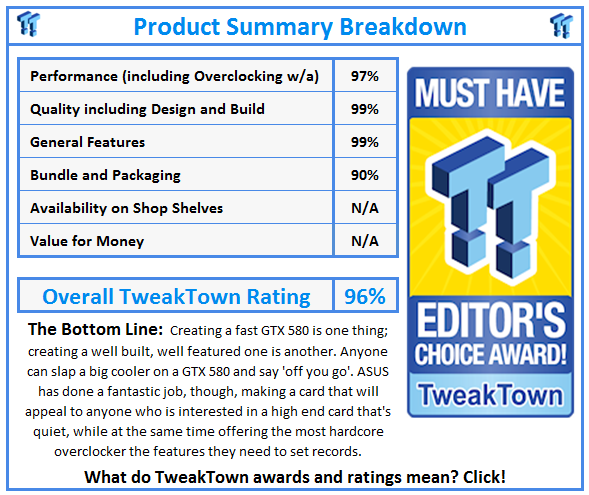
 United
States: Find other tech and computer products like this
over at
United
States: Find other tech and computer products like this
over at  United
Kingdom: Find other tech and computer products like this
over at
United
Kingdom: Find other tech and computer products like this
over at  Australia:
Find other tech and computer products like this over at
Australia:
Find other tech and computer products like this over at  Canada:
Find other tech and computer products like this over at
Canada:
Find other tech and computer products like this over at  Deutschland:
Finde andere Technik- und Computerprodukte wie dieses auf
Deutschland:
Finde andere Technik- und Computerprodukte wie dieses auf